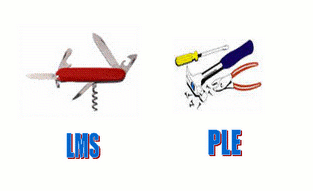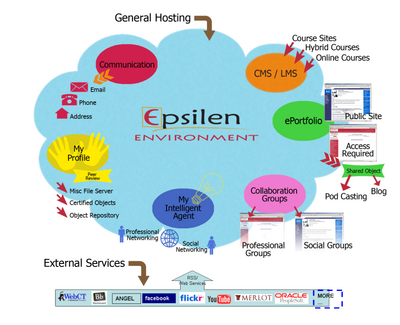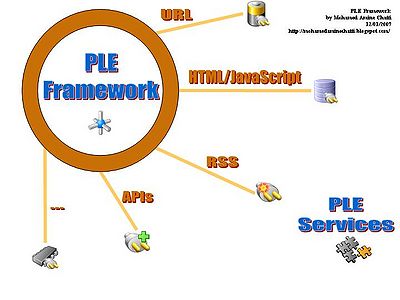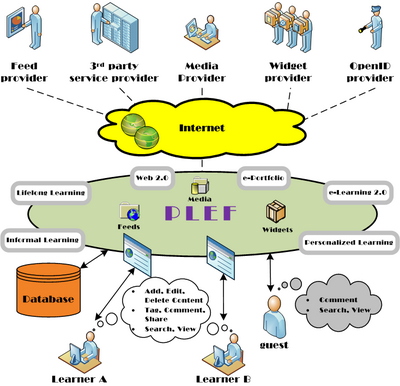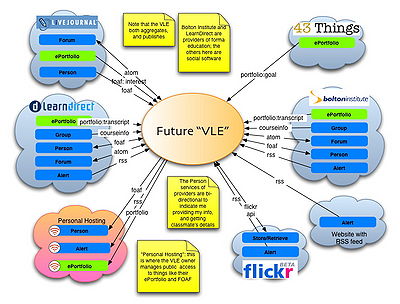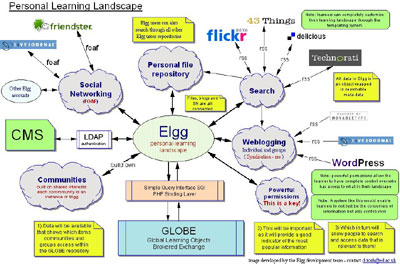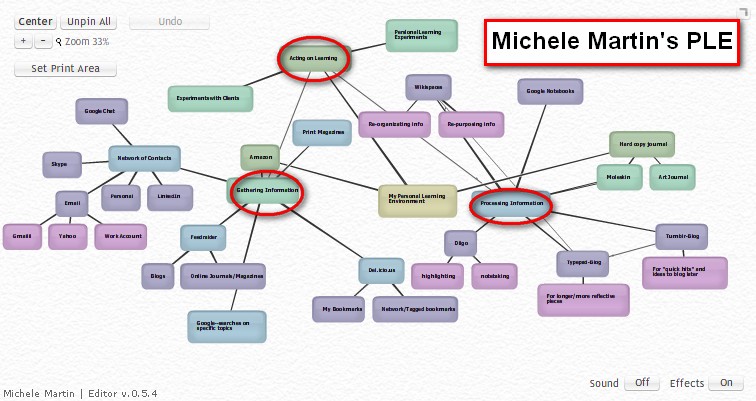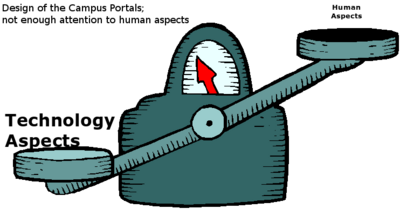Personal learning environment: Difference between revisions
m (using an external editor) |
m (using an external editor) |
||
| Line 260: | Line 260: | ||
[[Category: Rich internet applications]] | [[Category: Rich internet applications]] | ||
[[Category: Personal learning environments]] | [[Category: Personal learning environments]] | ||
[[fr:Environnement d'apprentissage personnel]] | |||
Revision as of 00:04, 7 May 2009
<pageby comments="false"/>
Definitions
Graham Attwell defines Personal Learning Environments (PLE) as an idea that firstly integrates "pressures and movements" like lifelong learning, informal learning, learning styles, new approaches to assessment, cognitive tools. Furthermore, PLEs are inspired by the success of "sticky" new technologies in ubiquitous computing and social software. ([1], retrieved 22:17, 25 April 2007 (MEST)]
“The most compelling argument for the PLE is to develop educational technology which can respond to the way people are using technology for learning and which allows them to themselves shape their own learning spaces, to form and join communities and to create, consume, remix, and share material”.([2], retrieved 22:17, 25 April 2007 (MEST)]
On also may define a PLE as a system (but some may not necessarily agree). E.g. Mark van Harmelen defines 'Personal Learning Environments as systems that help learners take control of and manage their own learning. This includes providing support for learners to set their own learning goals, manage their learning; managing both content and process, communicate with others in the process of learning, and thereby achieve learning goals. A PLE may be composed of one or more sub-systems: As such it may be a desktop application, or composed of one or more web-based services.' PLE Wiki (retrieved 22:17, 25 April 2007 (MEST)).
“A PLE is characterized by the freeform use of a set of lightweight services and tools that belong to and are controlled by individual learners. Rather than integrating different services into a centralized system, the idea is to provide the learner with a myriad of services and hand over control to her to select and use the services the way she deems fit. A PLE driven approach does not only provide personal spaces, which belong to and are controlled by the user, but also requires a social context by offering means to connect with other personal spaces for effective knowledge sharing and collaborative knowledge creation.” Mohamed A. Chatti
“A Personal Learning Environment is a facility for an individual to access, aggregate, configure and manipulate digital artifacts of their ongoing learning experience” Ron Lubensky, retrieved 22:17, 25 April 2007 (MEST).
See also Personal research and teaching environment, social software, web 2.0, e-learning 2.0, learning e-portfolio, rich internet application. For a more complete list of useful web 2.0 software consult the list of web 2.0 applications.
PLE Architectures
Daniel K. Schneider like many others doesn't believe that there is 'the' personal environment. While an institution may indeed provide a central access point to loosely coupled services within a web services-based architecture like e-framework, parts of it always will be external services and tools, cool things that "pop up" and are useful just for a precise learner or maybe a teacher and maybe outside a formal "school" context. Currently and technically, Daniel K. Schneider thinks that PLEs as systems are educational usage of virtual office or webtop applications or components.
The difference between an LMS and a PLE in the sense of a learner's open tool collection is nicely illustrated by this picture from Mohamed Amine Chatti who argues that “Rather than integrating different tools into a centralized system, the idea is to provide the learner with a myriad of tools and hand over control to her to select, combine and use the tools the way she deems fit.”.
Some weak idea of a PLE would be Sean FitzGerald's “A Personal Learning Environment (PLE) is a collection of free, distributed, web-based tools, usually centered around a blog, linked together and aggregating content using RSS feeds and simple HTML scripts.”
While its not clear whether a PLE is a system or an idea, a number of design criteria for next generation learning environments can be formulated, in particular the one that learners can shape their own learning space. Future learning environments have to be PLEs in at least some regards, since the whole history of educational technology demonstrates, that the most popular applications in education always have been professional tools, not software made specifically for education.
Therefore, one also could define a PLE in terms of tools it provides (see also the various architectures introduced below).
Jafari model
Jafari et al (2006) identify:
(1) Lifelong. The learning process is fluid. Learners can move between schools and between jobs and within the job between doing and just-in-time open learning. Therefore a system should not be campus-based, “the learner's e-portfolio being the foundation and the connecting point to the system. This new design model automatically creates an e-portfolio account for every learner, along with a personal URL or Web address, forming a lifelong learning repository, lifelong contact information, and a cyber-identity.” (Jafari, 2006).
(2) Outsourced to a organization that provides services to both learner (his whole life) and the school.
(3) Global. Break down walls, e.g. offer a FOAF-like Colleague of a colleague (COAC) service, e.g. let outsiders participate in educational activities.
(4) Comprehensive. “As illustrated in Figure 1 (below), the Jafari model also proposes a comprehensive, 'Swiss Army knife' toolbox - that is, all the necessary tools for day-to-day learning and teaching tasks. These include tools for L/CMSs, e-portfolios, social and professional networking, peer review, learning assessment, and object repositories, as well as various communication and collaboration tools. With this model, the L/CMS is only a subset and a component of the e-learning environment. This model emulates the successful Microsoft Office Suite by offering all the important tools a user needs. And if an advanced tool is not included, such as an implemented L/CMS system on campus, this model offers integration and connectivity. These functions can be obtained using existing integration practices such as Web services, API, and RSS.”
(5) Smart. Personal intelligent agent software forms a major component of the Jafari model. “The intelligent agent would have the capability to learn, to think, to reason, and to intelligently act and react on behalf of an individual learner. With this, the next generation of e-learning environment software becomes expert on an individual user, serving the user according to his or her personal requirements and desires”. Daniel K. Schneider is skeptical about this. Intelligent agents were popular in the ITS literature and precisely failed because they take away control for the user. Agents that would just help dealing with information (not serving information), is plenty enough.
Jafari's research on smart learning environment and intelligent agents both from conceptual and technical perspectives let to the current R&D Epsilen Environment. The picture below both illustrates the "Jafari model" and the implementation.
Chatti Integration of communities and services model
Chatti (2007) referring to Wenger argues that learners are members in multiple knowledge communities including learning communities (LC), communities of practice (CoP) and communities of interest (CoI). Therefore, central to his definition of a PLE is the integration of communities.
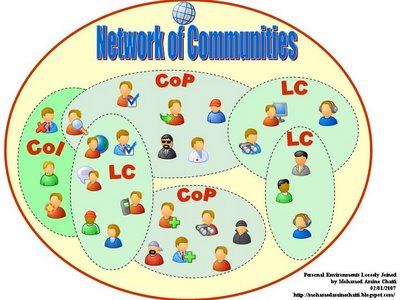
Chatti, in his PLE Links and Towards a Personal Learning Environment Framework post also presents a general PLE framework that emphasized the idea that a PLE is an application integrator. It raises the important question how and whether to specify "PLE services". “To the technical question of how PLEs can be best deployed, I believe that the challenge is how to design a PLE as an extensible framework that can be complemented with different supporting components. [...] Learners should be able to copy&paste, drag&drop and mash third-party services directly into their PLEs based on their needs and with a minimum effort.”, [3], retrieved 16:26, 23 May 2007 (MEST).
PLEF
The Personal Learning Environment Framework from University of Aachen is a more recent project in which M.A. Chatti participates.
The Personal Learning Environment Framework (PLEF) supports the learners in taking control over their learning experience by aggregating, managing, tagging, commenting, and sharing their favorite resources (e.g. feeds, widgets, and different media) within a personalized space. PLEF differs from popular personalized start pages such as iGoogle, My Yahoo, Netvibes, or Pageflakes mainly in six important points:
- PLEF uses OpenID for authentication.
- PLEF supports commenting and sharing of all PLE elements.
- Access control is defined at both PLE page and element levels.
- Besides a traditional page view, PLEF provides a tag view of all PLE elements. Learners can add tags in order to be able to classify, categorize, search and re-find their PLE elements at a later time.
- PLEF provides a navigation sidebar where you can (1) drag-and-drop to move PLE elements between pages or change the order of the pages, and (2) click a tag to see its associated elements.
- PLEF supports full-text and tag search of PLE elements.
The PLEX project
PLEX - Personal Learning Environment project is based on discussion of models for future VLEs. Scott Wilson presented (in several talks) what he calls the visual interpretation of a "VLE of the Future" realised with present technologies and services:
The PLEX system currently available does not implement all of this. PLEX is called a 'Personal Learning Toolkit (PLT) solution.
Some of its basic design concepts are:
- Feeds aggregate information from services
- Conduits publish information to services
- Views and Groups manage information
- People, Resources, Activities as the building blocks
Note: Daniel K. Schneider didn't give this software a try so far. Therefore no comments on the software itself.
ELGG, an aggregation portal
ELGG is a social software system that has gained quite a lot of attention in the educational community. Elgg is an open source social networking platform developed for LAMP (Linux, Apache, MySQL, PHP) which encompasses weblogging, file storage, RSS aggregation, personal profiles, FOAF functionality and more.
(There is also a bigger picture, but it seems to be corrupted)
ELGG features include: Blogging, Social networking, File repositories for individuals and communities, Podcast support, Full access controls, Supports tagging, User profiles, Full RSS support, RSS aggregator, Create communities, Collaborative community blogs, Create 'friends' networks, Import content, Publish to blog, Multilingual, Branding/customization
It has to be seen, how other portalware will spring up and integrated web 2.0 components, in particular popular social software.
Building your own with a webtop
See the webtop article for some technical background, and pageflakes for some ideas on how to combine teacher webtops with PLE.s
Michele Martin, (retrieved 22:17, 25 April 2007 (MEST)) describes in some details how she constructed her own personal Learning Environment, mostly with three kinds of free tools:
- Gathering Information
- Processing Information
- Acting on the Learning
Martin's endeavor is quite fascinating as it shows that there is a way of doing it for a tech-savy teacher. One problem was to find a central aggregating tool. She chose a webtop, i.e. Netvibes. Someone else used Protopage as described in the Join the dots: paint your own personal learning landscape presentation. Daniel K. Schneider make a test with Pageflakes (you can have a look at my page).
Alternatively or in combination with a webtop or any other "page" that allows you insert links and maybe feeds, it also might be possible to integrate "manually" various web widgets, rich internet applications etc. Please, see the list of web 2.0 applications. In this case it is probably a good idea to check whether these sites support OpenID, which is a a shared identity service, which allows Internet users to log on to many different web sites using a single digital identity.
Virtual office tools
Note: I probably should make this less google centric, there are other providers for virtual office services - Daniel K. Schneider.
Internet Companies such as Google do see the potential of such models. E.g. as of April 2007, Google offers an increasing amount of on-line tools, most of which can be used in an educational setting.
Google's Tools for your classroom page (Google for educators) explicitly mentions various specialized search tools such as Book Search, Earth, Maps, Personalized Homepage, Web Search and then points to applications like Blogger, Calendar, Docs & Spreadsheets, Picasa, SketchUp, Talk, Groups, News, Page Creator. Now using these tools in classroom doesn't make it a technically integrated environment. The question of who really needs something like an LMS for classroom teaching is another issue, but a future IT solution also of interest to higher education may be Google Apps Education Edition, an application that integrates some Google services. “Google Apps Education Edition is a broad IT solution that schools can use to bring communication and collaboration tools to the entire academic community for free. Google manages all the technology details, so you can focus your time, energy and budgets on teaching your kids.” [4], retrieved 22:17, 25 April 2007 (MEST). An other interesting bit is in the here.
There may be truth and a lot of future behind slogans like Powerful solutions - Zero investment. If you can have it for free and it works, why bother with administration that often makes life difficult for teachers and typical university portals that erase your data every few years or even after each terms? More importantly, several Google services can be integrated with existing IT systems through published extensibility APIs for web widgets.
Other do-it-yourself environments
- Zotero (Zotero website) is a free, easy-to-use Firefox extension to help you collect, manage, and cite your research sources. E.g. features automatic capture of citation information from web pages, Storage of PDFs, files, images, links, and whole web pages, flexible notetaking with autosave, fast, as-you-type search through your materials, playlist-like library organization.
- Mindpicnic, Courses at Mindpicnic are a simple method of organizing and sharing large amounts of study material. More precisely, a course is an ordered collection of cardboxes, books, links and notes referring to one topic.
PLEs and instructional design models
How can we tie this technology to appropriate instructional design models or more simply put "how can this be useful to educators who think in terms of pedagogic strategy" ? Some people, e.g. Hiebert (2003) make a point that at some point one should wonder whether to design for educators or for students, i.e. he raises issues that have to do with “the tyranny of curriculum (and testing), teachers' desire to control learning, the value of for-fee online content, and student motivation in self-directed learning....”. So a first simple argument in favor is that will support so-called "new pedagogies" as opposed to behaviorist instructional design. However, this is more of a political than an operational stance.
Here is a provisional list of models for which PLEs may provide support:
- informal learning like mentoring or on the spot learning, etc. No problem here.
- Adult learning in a community of practice. A PLE could add value to individuals who could monitor activities in the community's social software (e.g. a wiki) and individual reflective or exploratory writing (e.g. blogs).
- Various sorts of project-oriented learning like inquiry-based learning, problem-based learning, project-based learning, project-methodology-based learning, case-based learning. The questions on how a teacher can more or less efficiently scenarize, manage, and monitor student activities or how students will collaborate and not get lost in "Web 2.0" space are open. He can not just configure his own PLE to syndicate. Ideally, there should be some place where student activities are shown to each member.
- More formal Writing-to-learn, Knowledge-building community model designs, etc. A PLE would be both an individual Computer Supported Intentional Learning Environment and a collective one (under the condition that central services are collectively used tools).
In some ways ELGG does address some of the coordination issues raised here, but frankly speaking Daniel K. Schneider (the initial and lonely author or this piece) didn't make up his mind yet. I need some real hands-on experience.
Discussion
Daniel K. Schneider doubts that any company will be able to "corner the market" for this in the very near future since there ought to be standards to exchange all the personal incorporated data from one system to another. On the other hand, since integration portals may just leverage existing popular applications, they do not need to deal with most of the data. There may be competition/solutions from several sides:
- Existing "closed" portals like LMSs may increasingly open up to various web services (E.g. Moodle - ELGG or Moodle - Mediawiki integration modules.)
- New educational integrator systems like something based on Jafari's model (outsourcing the integrator and the data)
- Something in between like e-framework
- Global service providers like Google (or MS) that provide virtual portals around their own services.
One big question is to decide whether a PLE is a concept or a system. “The PLE wiki defines a PLE as systems that help learners take control of and manage their own learning.I do not agree with this. A PLE is a concept, not a system. Different applications (especially web services) can be integrated and used as a PLE. So, I think a PLE is more SOA-based (although applications not always have to be integrated, they can also become combined). This would imply that a PLE is not the same LMS/VLE+Web 2.0. It's personalization, networking and collaborating. See my comments in a different blog entry.” (Wilfred Rubens, retrieved 22:17, 25 April 2007 (MEST)).
A next one is why replace current systems, that painfully found their way into our academic lifes. Terry Anderson (2006), in a blog entry is quite sceptical that PLEs will replace LMSs anytime soon. “Although there is something quite compelling about the vision of a lifelong learning environment that is centered upon and perpetually belongs to the learner, I think we are some distance from being able to operationalize that vision [...] PLEs are nowhere near as easy to use to facilitate and support many of the educational functions that are trivial in modern LMS systems”, in particular “to create their own web courses with minimal programming expertise or even instructional design support”.
But then, Jafari in one his talks argues that current campus system (including LMSs) are not sticky, contrary to popular web 2.0 applications. There are several reasons, one of which is that these systems are not based based on fundamental needs a modern learner has, e.g. managing very different information and communication spaces as well as production tools.
. Therefore one could expect that adoption, may be much faster, at least in places where teachers still can decide what technology they wish to use in their classroom.
Ron Lubensky (2006) beliefs that the success of PLEs (those which are independent of commercial VLEs) will depend on:
- the ease with which they can be implemented and used by learners
- interoperability
- the confidence that learners and institutional administrators have with them.
Daniel K. Schneider can only agree with this. The 2007 Horizon report produced by influential New Media Consortium and die EDUCAUSE Learning Initiative put User-Created Content and Social Networking in the one year or less adoption category. These two functionalities are the starting point for personally built PLEs.
Links
Modeling languages
- LISL (implemented with Mupple).
Software
- Specifically made for education
- Epsilen environment. A PLE environment prototype (Jafari).
- PLEX. This is a free PLE developed at Bolton, platform independent. It features Manage Activities, People and Resources; Opportunities Explorer; RSS subscription; Atom, FOAF, Blogger support; MS Enterprise support; Monkey JavaScript support; Resource manager view to organize your favorite files and web links and more.
- PLEF - Personal Learning Environment Framework. This is a free service, OpenID enabled.
- Social software integrators
- See the virtual office and webtop articles. Teachers: Read these to get ideas on how find virtual desktops and other integration toolkits for your classroom. These articles also list Web2.0 components (but also look at the lists in social software)
- Social portals
Indexes
- Mohamed Amine Chatti's PLE links
- Personal Learning Environments Reading List, Part of Guide to Learning Tools. See also the info sheet
- Overview of Personal Learning Environments, Wiki page from the Learning Technologies Centre, University of Manitoba.
Web sites, blogs, events
- History of personal learning environments (Wikipedia)
- PLE Wiki
- Ali Jafari Home Page
- Personal Learning Environments Wiki Pages by Mark van Harmelen. Probably the best inventory of PLEs (including pictures and links).
- PLE_Workshop_2006 links
- PLE links by Ron Lubensky
- Personal Learning Environments Wiki
- The personal learning environments blog (PLE project at Bolton University)
More examples
- Ray's Personal Learning Environment (concept map)
- ELGG RoadMap
References
- Anderson, Terry (2006), PLE's versus LMS: Are PLEs ready for Prime time?, Virtual Canuck, Blog Entry, HTML
- Attwell, Graham (2006). Personal Learning Environments, Blog-Entry.HTML, retrieved 22:17, 25 April 2007 (MEST).
- Attwell, Graham (2007). Personal Learning Environments for creating, consuming, remixing and sharing, Blog-Entry. HTML, retrieved 22:17, 25 April 2007 (MEST).
- Attwell Graham (2007), Personal Learning Environments - the future of eLearning?, eLearning Papers 2(1), ISSN 1887-1542, January 2007. PDF
- Blackall, Leigh (2005). Die LMS die! You too PLE!, Blog Entry, HTML
- Chatti, Mohamed Amine (2007), Towards a Personal Learning Environment Framework, Blog Entry, HTML
- Chatti, Mohamed Amine (2007). Personal Environments Loosely Joined, HTML, , retrieved 22:17, 25 April 2007 (MEST).
- Chatti, Mohamed Amine (2007). LMS vs. PLE, HTML, retrieved 22:17, 25 April 2007 (MEST).
- Downes, Stephen (2007). Personal Learning, Talk PPT
- Farmer, James (2006). The Inevitable Personal Learning Environment Post, Blog Entry, HTML.
- FitzGerald, Sean, Creating your Personal Learning Environment, HTML
- Hiebert, Jeremy (2003). Designing for Educators or Students? Blot Entry, HTML
- Jafari, Ali; Patricia McGee, and Colleen Carmean (2006). Managing Courses, Defining Learning: What Faculty, Students, and Administrators Want, EDUCAUSE Review, vol. 41, no. 4 (July/August 2006): 50-71. HTML.
- Martin, Michele (2007). My Personal Learning Environment, Blog Entry HTML, retrieved 22:17, 25 April 2007 (MEST)
- Lubensky, Ron (2006). The present and future of Personal Learning Environments (PLE), Blog Entry,HTML
- Personal Learning environments (2008), Special Issue, elearning-papers 9. Index
- van Harmelen, M. (2006). Personal Learning Environments. Proceedings of the 6th International Conference on Advanced Learning Technologies (ICALT'06), IEEE.
- Vuorikari, R. (2005). Can personal digital knowledge artefacts' management and social networks enhance learning? European SchoolNet, EUN Consortium, Brussels. PDF.
- Wilson, Scott (2006). PLEX, Experiences in building a composite application, Slides PPT
